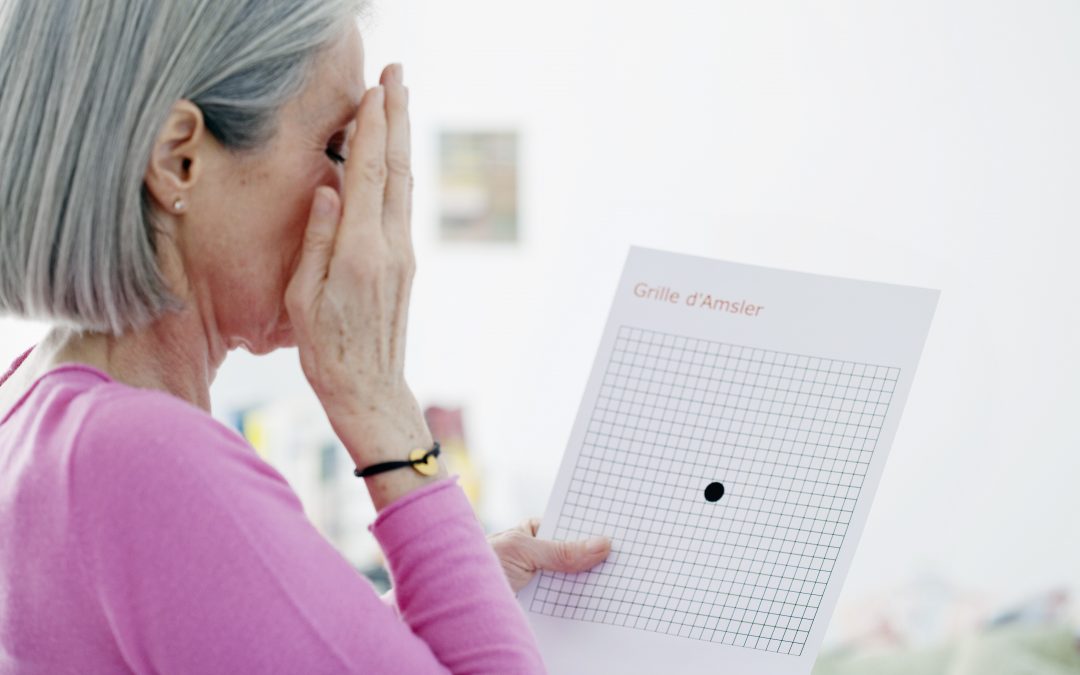What is age related macular degeneration and what can we do about it?
As briefly referenced in our what causes vision loss when you get older age related macular degeneration (AMD) usually starts affecting people in their 60’s and it can manifest itself as early as your 50’s.
Unfortunately AMD is the leading cause of severe and irreversible vision loss. This is when the macula – the small central portion of the retina deteriorates. The retina is the light sensing tissue part at the back of the eye. It is referred to age-related muscular degeneration as the disease develops as a person ages.
Although AMD doesn’t render a person totally blind, it can result in a significant visual disability.
Are there different types of AMD?
Yes there are. There are 2 main types of age-related macular degeneration:
Dry Form
This is represented by the presence of yellow deposits called drusen – in the macular. A few small drusen may not impact or cause any changes in vision, however, as they grow in size and multiply in number they can lead to a dimming or distortion of vision.
In more advanced stages of dry macular degeneration there is a thinning of the light sensitive layer of cells in the macular, resulting in tissue death. In the early stages patients may have blind spots in their centre of their vision; in the advanced stages patients will lose central vision.
Wet Form
The ‘wet’ form of macular degeneration is proven by the growth of abnormal blood vessels from the choroid (the vascular layer of the eye) underneath the macula. Called choroidal neovascularisation these blood vessels leak blood and fluid into the retina causing vision distortion. Continued bleeding from these abnormal blood vessels will eventually form a scar, leading to a permanent loss in central vision.
The dry form is the most common form of macular degeneration – and can lose some central vision. It’s worth noting that people with the dry form can develop the wet form. Although only 10% of patients suffer the wet form, they still make up the majority that will suffer serious vision loss from the disease.
Another form of macular degeneration is JMD (juvenile muscular degeneration). This is the term for several inherited and rare diseases that affect young adults and children, and it can cause central vision loss at a much younger age.
What are the risk factors?
- Age is the most prevalent risk factor, as we age, the risks increase.
- It can be hereditary, passed from parents to children. If someone in the family has the condition, it is worth checking with a specialist about your individual risk.
- Looking after your general health utilising fitness and nutrition can help mitigate risk factors including smoking, high blood pressure, high cholesterol and obesity.
- Other risk factors include females, light-skinned and light eye colour.
What are the symptoms
In the very early stages, macular degeneration can be symptomless. Unfortunately not detected until it progresses or affects both eyes.
The most common symptom of AMD is experiencing a blurred or distorted area in your vision If this deteriorates people often struggle to see anything in the middle of their vision.
Other symptoms may include:
- Seeing straight lines/edges as wavy or crooked.
- Objects seem smaller than normal.
- Dimming of colours. Looking less bright than used to.
- Hallucinating. Foreign objects appearing in your vision.
What help is available?
Early diagnosis and treatment may help stop your vision getting worse. So seeing a specialist at any sign of the above symptoms is highly recommended.
- Anti-angiogenesis drugs.
- These can help to block the development of new blood vessels and leakage from the existing abnormal blood vessels.
- Vitamins.
In a study conducted by the National Eye Institute of the National Institutes of Health it showed that for certain individuals vitamins C, E, copper, Zinc and beta-carotene can help decrease the vision loss in certain stages of AMD.
Laser & Photodynamic laser therapy
The two types of treatment can be used with the aim of destroying and/or damaging the abnormal blood vessels.
Low Vision Aids
More of an assistance than a potential cure. These aids have special lenses that produced enlarged images of nearby objects, allowing a patient to maximise their remaining vision.
@Home Healthcare is here to help. Should you have any concerns or questions on any of the information presented here, whether it’s for you or someone else, please don’t; hesitate to get in touch. We are always happy to help and offer solid advice. Call us on 0333 335 0068 .


